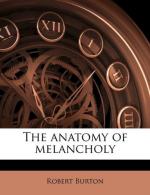Other signs there are taken from physiognomy, metoposcopy, chiromancy, which because Joh. de Indagine, and Rotman, the landgrave of Hesse his mathematician, not long since in his Chiromancy; Baptista Porta, in his celestial Physiognomy, have proved to hold great affinity with astrology, to satisfy the curious, I am the more willing to insert.
The general notions [1293]physiognomers give, be these; “black colour argues natural melancholy; so doth leanness, hirsuteness, broad veins, much hair on the brows,” saith [1294]Gratanarolus, cap. 7, and a little head, out of Aristotle, high sanguine, red colour, shows head melancholy; they that stutter and are bald, will be soonest melancholy, (as Avicenna supposeth,) by reason of the dryness of their brains; but he that will know more of the several signs of humour and wits out of physiognomy, let him consult with old Adamantus and Polemus, that comment, or rather paraphrase upon Aristotle’s Physiognomy, Baptista Porta’s four pleasant books, Michael Scot de secretis naturae, John de Indagine, Montaltus, Antony Zara. anat. ingeniorum, sect. 1. memb. 13. et lib. 4.
Chiromancy hath these aphorisms to foretell melancholy, Tasneir. lib. 5. cap. 2, who hath comprehended the sum of John de Indagine: Tricassus, Corvinus, and others in his book, thus hath it; [1295]"The Saturnine line going from the rascetta through the hand, to Saturn’s mount, and there intersected by certain little lines, argues melancholy; so if the vital and natural make an acute angle, Aphorism 100. The saturnine, hepatic, and natural lines, making a gross triangle in the hand, argue as much;” which Goclenius, cap. 5. Chiros. repeats verbatim out of him. In general they conclude all, that if Saturn’s mount be full of many small lines and intersections, [1296]"such men are most part melancholy, miserable and full of disquietness, care and trouble, continually vexed with anxious and bitter thoughts, always sorrowful, fearful, suspicious; they delight in husbandry, buildings, pools, marshes, springs, woods, walks,” &c. Thaddaeus Haggesius, in his Metoposcopia, hath certain aphorisms derived from Saturn’s lines in the forehead, by which he collects a melancholy disposition; and [1297]Baptista Porta makes observations from those other parts of the body, as if a spot be over the




